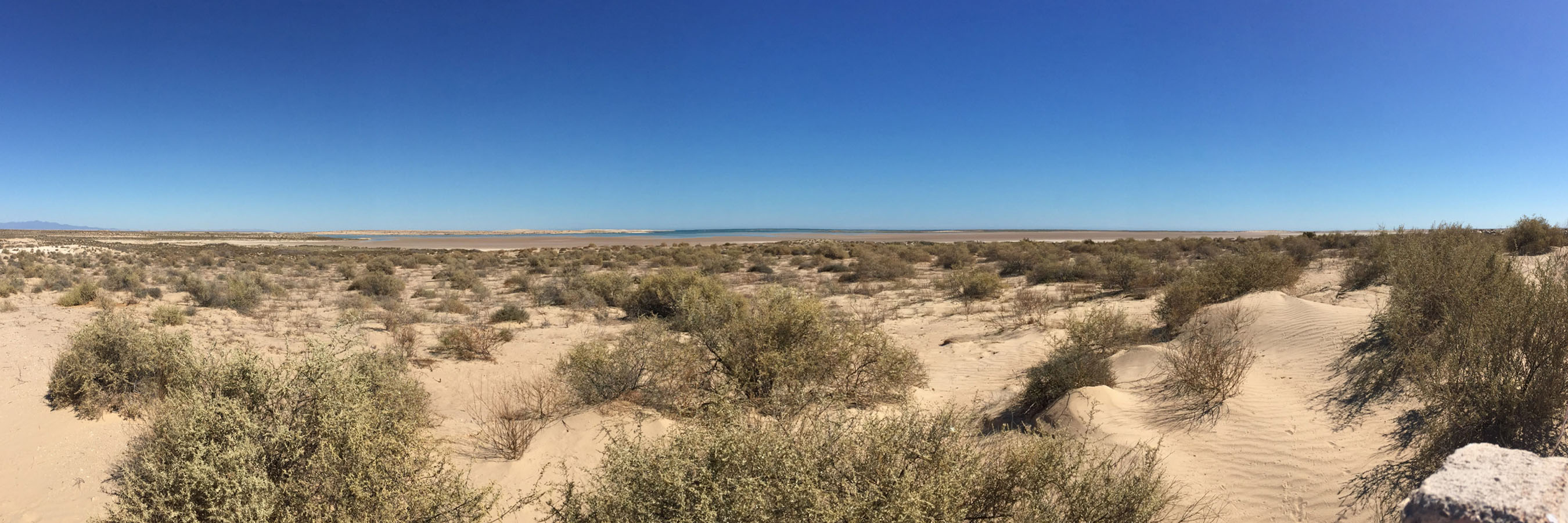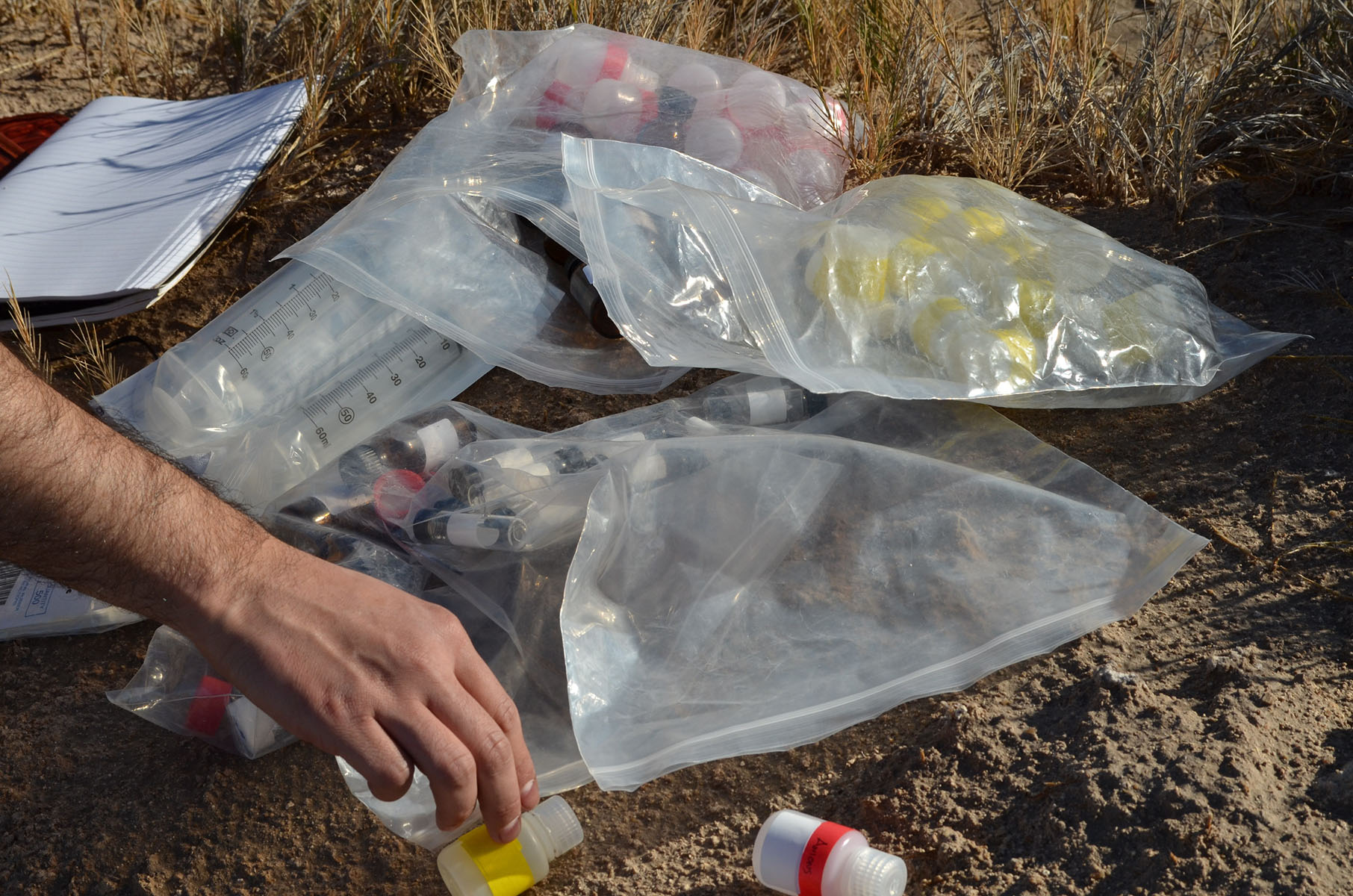Driving along the highway through northwestern Mexico’s Gran Desierto you might not notice the pozos dotted amongst the seemingly endless sand dunes. Most drivers don’t. Yet these pozos provide fresh water critical to a diversity of life. Historically, pozos were central to the physical and cultural nourishment of the people of the area as well. Now, most people just drive by unaware of these incredible sources of water and life.
Ben Wilder, the acting Director of The Desert Laboratory on Tumamoc Hill and a Research Scientist in desert ecology and botany from the University of Arizona, and Ben Johnson, a visual artist and curator from Tucson, Arizona, do not drive by. Wilder and Johnson are working together through the 6&6 Project and have chosen to focus their work on the pozos. Forged by the Next Generation Sonoran Desert Researchers network (N-Gen, www.nextgensd.com), the 6&6 Project is a collaboration between artists and scientists to explore the patterns and processes of the Sonoran Desert and Gulf of California. Using their art and science Wilder and Johnson are peeling back the layers of archaeology, botany, ecology, geology and hydrology that comprise the wonder of the pozos. Through their explorations they are raising awareness and understanding of the pozos and also contemplating what it means that we have become disconnected from them.
Ben Wilder has long sought an opportunity to explore these landscapes that have been of intrigue to him. Wilder’s PhD advisor Exequiel Ezcurra and mentor Richard Felger first introduced him to pozos. In 1988 Ezcurra and Felger published a pioneering scientific paper on pozos, documenting the flora and beginning to ask, “Where is this water coming from?” Upon his first visit to a pozo, on which he was joined by Paul Dayton from the Scripp’s Institute of Oceanography, Wilder shares, “I was just kind of captivated –as Exequiel and Richard and Carl Lumhultz and people for millennia have been captivated by this site– and settled in my mind that it would be great to do a research project there at some point.” Wilder found himself circling back to the question: “Where is the water for these springs coming from?” A question especially critical in the binational Sonoran Desert region where “water is more precious than gold”. A question he recognized he would need some help answering: “I’m a botanist, and while I have hydrological questions I have no idea what I’m doing to figure them out, working with stable isotopes and what not.” Wilder was able to connect with a graduate student at the University of Arizona, Hector Zamora, who had been working on similar questions in the area, but had not yet considered the pozos. With Hector on board to help with the hydrology, Wilder was looking for ways to weave in other pieces of the pozos story and found the combined lenses of art and science to be a compelling approach.

Ben Johnson came to the 6&6 Project less familiar with pozos, but at a point where he was looking to explore new directions with his art. Having previously focused much of his work on birds, he was eager to “be as open as possible to whatever artwork needed to come out of this.” Johnson explains, “I wanted to be present for that [process] rather than come to this project with some predetermined idea… I really came to this project with open eyes, open hands, open everything. Just let’s see what would be cool to experiment with here.” Johnson was especially interested in using his work to explore “this idea of telling multiple stories on one surface, so on one canvas telling overlapping stories and weaving cultural influences with historical and scientific influences.” He was captivated by the multi-layered story of the pozos Wilder shared. “I’ll say the project in my brain, it really just caught fire with ideas immediately. That was when I knew that this was going to be a perfect project for my transition.”
The work has held surprises for both Johnson and Wilder, and has required them to stretch beyond their previous work. In each instance the project and participants have adapted to what the pozos have dictated, sometimes learning new skills other times bringing in collaborators. The central question of Where does this water come from? has pushed them to learn more about hydrology. For Johnson, “It kind of blew my mind… The fact that you can get a fingerprint on water. That water carries with it a very distinctive signature. That in itself was such a fascinating idea to me.” During stable isotope analysis, “Each water source has a unique signature –be it rainwater, be it groundwater, be it Gila River water, be it old ancient rainwater— you look at getting that signature of those different potential sources and then, of course, the pozos water themselves and then try to see where that falls out. And what the relationships are.” Additionally, radio carbon analysis is used to determine the approximate age of the water. Together this data serves as a central thread that runs through the story of the pozos. Wilder describes waiting for the results being like “baking a cake and we’re about to add one of the most important ingredients and we don’t know what it is.”

The data from these analyses will be incorporated into a multi-piece display. Johnson and Wilder initially tried to pull pieces of the story apart but discovered that “it is the network of all of these concepts and realities that we found so interesting.” After considering a series of framed nature boxes, which Wilder admits in retrospect was “almost too literal,” Johnson boldly proposed a different direction. According to Wilder, “One day he [Johnson] came to me. I was sick and had just gotten over traveling. I was a bit overwhelmed and I thought it was just going to be a check-up meeting. He said, ‘Well, I’m thinking about totally changing our prospective.’ I slept on it, and [replied], ‘That makes absolute, complete sense. Both in the direction of where you’re going with your art and what this storytelling means.’”
To bring the multiple layers together, “the final artwork piece is going to be a wall installation composed of a number of fairly large paintings with some other components hung with the canvases.” The paintings will feature representations of the cultural and historical exploration stories of the pozos, with photographs and maps from the Norwegian explorer Lumholtz who traversed the region on horse back in 1912, a trip preserved in time in his classic book New Trails in Mexico, alongside modern maps of the highway that cuts through the region. Two monitors will accompany the canvases. Intimate shots of herons, coyotes, and bats visiting the pozos caught by camera traps will be shown on one monitor. The other will display, “an assembled time lapse series of photographs. It is going to slowly transition from Lumholtz’s [photograph] in 1912 of one of the pozos through time lapse photography to that exact same spot presently.” The highway makes another appearance in the time lapse video. “One of the amazing things in the particular camera match is that currently you can see the highway from the view of Lumhotz’s photograph. So the time lapse will actually extend into evening. You see the sun set and then you’ll get the darkness, and then you get all of the headlights of all the cars and trucks going by.”
![Match Image [Top] Carl Lumholtz [Bottom] Ben Johnson](https://mahb.stanford.edu/wp-content/uploads/2017/05/Pozo-at-Salina-Grande_seen-from-east-Match.jpg)
For Wilder, the time lapse piece is a great example of how tools are shared across science and art: “For me, I’m coming at repeat photography as this really great tool to monitor change over time across the landscape… then creating this beautiful time lapse artistry and having what was usually a static image in how it’s been depicted in science, and being able to bring it alive.” Johnson pointed to the botanical samples they will be incorporating as another example of pieces in which “there’s genuine science happening there and then there’s also genuine artwork.”
With all the different layers to the story coming together, now Johnson’s concerns stem from wondering if they can fit it all in: “…as an artist the nervous part is can we? Can we get all this in there? Can we get all that excitement into a visual piece of art? I believe it’s a definite yes. And I’m really excited to see that magic happen.”

Of particular interest to both Johnson and Wilder is the human component of the story and how they can manage to incorporate it. One of the most impressive features of the site are the massive shell middens left by people. As Wilder describes it, “…you’re just standing out on these salt flats on these massive strands of shell middens that are meters thick and they’re deposited by people. To me it’s this resounding message that the water is here, and people have known this for millennia.” Yet today, “we’re disconnected from that fact.” Wilder admits, “The magnitude of that [relationship], and the past presence of people is something I’m really still grappling with in my mind… And what that means to the data and how we present that data.” Ultimately, our relationship with water has changed, and therefore so has our relationship with the pozos. The hotter and drier future that is predicted may very well force this relationship to change again as expansive ground water pumping increases. Johnson and Wilder want to ensure that the story of the pozos, with its multiple layers, is shared and understood before they are lost.
This project is part of the 6&6 collaboration introduced last week. You can find out more about 6&6 here. The MAHB will be featuring additional scientist-artist partnerships from the collaboration in the coming week.
The above post is through the MAHB’s Arts Community space –an open space for MAHB members to share, discuss, and connect with artwork processes and products pushing for change. Please visit the MAHB Arts Community to share and reflect on how art can promote critical changes in behavior and systems and contact Erika with any questions or suggestions you have regarding the space.
MAHB Blog: https://mahb.stanford.edu/creative-expressions/stopping-for-pozos/
The views and opinions expressed through the MAHB Website are those of the contributing authors and do not necessarily reflect an official position of the MAHB. The MAHB aims to share a range of perspectives and welcomes the discussions that they prompt.
